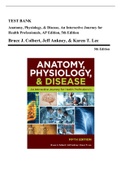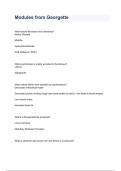TEST BANK
Anatomy, Physiology, & Disease, An Interactive Journey for
Health Professionals, AP Edition, 5th Edition
Bruce J. Colbert, Jeff Ankney, & Karen T. Lee
5th Edition
,Table of Contents
Chapter 01 Anatomy, Physiology, and Disease 1
Chapter 02 The Human Body 13
Chapter 03 Biochemistry 22
Chapter 04 The Cells 31
Chapter 05 Tissues and Systems 41
Chapter 06 The Skeletal System 50
Chapter 07 The Muscular System 62
Chapter 08 The Integumentary System 74
Chapter 09 The Nervous System 89
Chapter 10 The Endocrine System 110
Chapter 11 The Senses 121
Chapter 12 The Cardiovascular System 132
Chapter 13 The Respiratory System 148
Chapter 14 The Lymphatic and Immune Systems 161
Chapter 15 The Gastrointestinal System 175
Chapter 16 The Urinary System 190
Chapter 17 The Reproductive System 205
Chapter 18 Basic Diagnostic Tests 221
Chapter 19 Anatomy and Physiology and the Scientific Method 232
Chapter 20 The Journey's End 237
Chapter 21 Health Care Careers and Career Planning 250
, ______________________________________________________________________________________________
Test Bank - Anatomy, Physiology, & Disease, An Interactive Journey for Health Professionals, AP 5e, (Colbert, 2020)
Anatomy, Physiology, & Disease, 5e (Colbert/Ankney/Lee)
Chapter 01 Anatomy, Physiology, and Disease
1.1 Multiple Choice Questions
1) Gross anatomy is also known as ________.
A) microscopic anatomy
B) pathologic anatomy
C) macroscopic anatomy
D) diagnostic anatomy
Answer: C
2) An example of gross anatomy would be ________.
A) viewing an x-ray
B) using a microscope
C) performing a complete cellular blood count
D) determining the etiology of a disease
W W W . T B S M . W S
Answer: A
3) The study of physiology deals with ________.
A) disease
B) genetics
C) structures
D) functions
Answer: D
4) The potential outcome of a disease is the ________.
A) etiology
B) diagnosis
C) prognosis
D) treatment
Answer: C
5) The study of disease is known as ________.
A) neurology
B) pathology
C) microbiology
D) cytology
Answer: B
6) The three basic parts of a medical term are ________.
A) prefix, word root, suffix
B) suffix, base, meaning
C) prefix, stem, ending
D) base, word root, stem
Answer: A
______________________________________________________________________________________________
1|Page
TBSM.WS@YAHOO.COM
, ______________________________________________________________________________________________
Test Bank - Anatomy, Physiology, & Disease, An Interactive Journey for Health Professionals, AP 5e, (Colbert, 2020)
7) What system is known as the mathematical language of medicine?
A) Abbreviation system
B) Metric system
C) English system
D) Customary system
Answer: B
8) Which of the following is NOT a vital sign?
A) Heart rate
B) Temperature
C) Odor
D) Respiratory rate
Answer: C
9) When the physician has documented several signs and symptoms, he or she will be
able to make a(n) ________.
A) prognosis
W W W . T B S M . W S
B) etiology
C) cytology
D) diagnosis
Answer: D
10) The adjustments that maintain a stable environment within the body are known as
________.
A) homeostasis
B) metabolism
C) syndrome
D) pathology
Answer: A
11) The body uses feedback loops to maintain homeostasis. The response that
opposes an action is known as a(n) ________.
A) depressing feedback loop
B) negative feedback loop
C) positive feedback loop
D) affirmative feedback loop
Answer: B
12) A positive feedback loop is necessary in which of the following situations?
A) Blood pressure
B) Coughing
C) Bleeding
D) Childbirth
Answer: D
______________________________________________________________________________________________
2|Page
TBSM.WS@YAHOO.COM
, ______________________________________________________________________________________________
Test Bank - Anatomy, Physiology, & Disease, An Interactive Journey for Health Professionals, AP 5e, (Colbert, 2020)
13) Vital signs include all of the following EXCEPT ________.
A) coloring
B) heart rate
C) respirations
D) temperature
Answer: A
14) RBC is the abbreviation for ________.
A) really bad cut
B) red and blue circulation
C) red blood cells
D) ruptured blood clot
Answer: C
15) The nurse found a preoperative patient out of bed, barefoot, and watching TV while
eating breakfast. "We have to cancel your surgery, because you're not NPO," the nurse
said. What did the patient do wrong?
W W W . T B S M . W S
A) The patient ate food.
B) The patient watched TV.
C) The patient walked barefoot.
D) The patient left the hospital bed.
Answer: A
16) A patient rang the call bell because he was in great pain. "I want my p.r.n.
medication now," he said. Which medication timing is the nurse going to follow?
A) Medications given in the morning
B) Medications given at noontime
C) Medications given in the evening
D) Medications given when needed
Answer: D
17) A lab technician finishes a test. "The CBC results are in the computer," she tells her
supervisor. What body fluid did the technician examine?
A) Saliva
B) Urine
C) Blood
D) Cerebrospinal fluid
Answer: C
18) All members of the Code Team have to take ACLS training annually. Which organs
will they practice reviving?
A) Eyes and ears
B) Heart and lungs
C) Nose and throat
D) Stomach and colon
Answer: B
______________________________________________________________________________________________
3|Page
TBSM.WS@YAHOO.COM
, ______________________________________________________________________________________________
Test Bank - Anatomy, Physiology, & Disease, An Interactive Journey for Health Professionals, AP 5e, (Colbert, 2020)
19) If a patient complains of SOB, which body system is having a problem?
A) Urinary
B) Neurological
C) Reproductive
D) Respiratory
Answer: D
20) The indicators that are essential for human life include all of the following EXCEPT
________.
A) coloring
B) heart rate
C) respirations
D) temperature
Answer: A
21) Which is NOT a definition for disease?
A) Not at ease
W W W . T B S M . W S
B) A condition in which the body fails to function normally
C) Anything that is a normal structure or function
D) Anything that upsets normal structure or function
Answer: C
22) The term tachycardia means "________."
A) fast heart rate
B) slow heart rate
C) rhythmic heart rate
D) study of the heart rate
Answer: A
23) Which is NOT a symptom of metabolic syndrome?
A) High triglycerides
B) Low HDL level
C) High blood pressure
D) Vomiting and diarrhea
Answer: D
24) A sign that could be an indication of diabetes is breath that smells like ________.
A) fruit-flavored chewing gum
B) clay or starchy paste
C) sweat
D) maple
Answer: A
______________________________________________________________________________________________
4|Page
TBSM.WS@YAHOO.COM
, ______________________________________________________________________________________________
Test Bank - Anatomy, Physiology, & Disease, An Interactive Journey for Health Professionals, AP 5e, (Colbert, 2020)
25) The prefix hyper- means "________."
A) small
B) above normal
C) below normal
D) within
Answer: B
26) The suffix -oma means "________."
A) cutting into
B) enlargement of
C) surgically forming an opening
D) tumor
Answer: D
27) The suffix -algia means "________."
A) inflammation
B) cell
W W W . T B S M . W S
C) pertaining to
D) pain
Answer: D
28) Most fevers are the body's way of ________.
A) killing all pathogens
B) breaking up the cells of pathogens
C) making an inhospitable environment for pathogens to survive
D) preventing pathogens from reproducing
Answer: C
29) Sweating at night may indicate ________.
A) tuberculosis
B) Hodgkin's disease
C) riboflavin deficiency
D) skin cancer
Answer: A
30) According to the rules of medical terminology, hepatitis is defined as "________."
A) liver failure
B) inflammation of the liver
C) cirrhosis
D) blood clotting
Answer: B
______________________________________________________________________________________________
5|Page
TBSM.WS@YAHOO.COM
, ______________________________________________________________________________________________
Test Bank - Anatomy, Physiology, & Disease, An Interactive Journey for Health Professionals, AP 5e, (Colbert, 2020)
31) The abbreviation used for "twice a day" is ________.
A) q.i.d.
B) t.i.d.
C) p.r.n.
D) b.i.d.
Answer: D
32) Volumes expressed as ounces, pints, quarts, gallons, pecks, bushels, or cubic feet
are examples of the ________.
A) metric system
B) English system
C) scientific notation
D) International System
Answer: B
33) A nurse found the vital sign he measured in millimeters of mercury to be highly
elevated. What condition does his patient have?
W W W . T B S M . W S
A) Hypertension
B) Fever
C) Hyperalgia
D) Heart attack
Answer: A
34) A student concentrates on moving decimal points in the correct direction while
completing her pharmacology homework. Which system of measurement is she using?
A) English
B) National
C) British Imperial
D) Metric
Answer: D
35) Normal adult cardiac output is 6,000 milliliters every 60 seconds. How is this amount
of blood being measured?
A) Volume in English units
B) Volume in metric units
C) Length in English units
D) Length in metric units
Answer: B
36) "I always have to use a conversion table," a student complained. Which system of
measurement is the student most likely using?
A) English
B) National
C) American Imperial
D) Metric
Answer: A
______________________________________________________________________________________________
6|Page
TBSM.WS@YAHOO.COM





